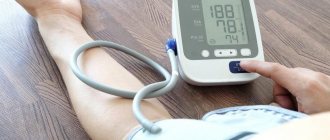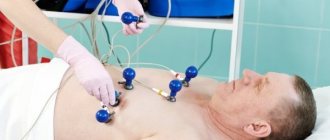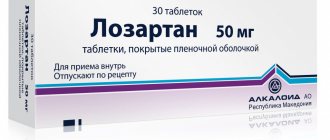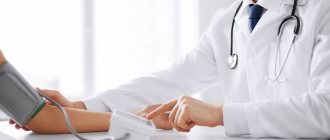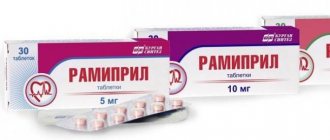Increased blood pressure in a healthy person is a natural reaction to stress and physical activity. A problem is indicated if, after three control measurements, the blood pressure exceeds 140/90. Then the most likely diagnosis is hypertension.
For most people, the disease does not produce symptoms, hence its second name: the silent or invisible killer. The first symptoms appear when the body ceases to independently withstand such a load and critical changes occur in the blood vessels. The first signs are:
- Increased anxiety.
- Cardiopalmus.
- Facial redness.
- Shortness of breath and dizziness.
- Headache and feeling of pressure in the temples.
- Chest pain in the region of the heart.
- Visual acuity decreases.
Fatigue, similar to the onset of a cold, is also a characteristic symptom. Accompanied by redness of the eyes, drowsiness and irritability. If the pressure approaches the extreme level, this is a reason to consult a doctor.
High blood pressure is divided into two categories: primary (essential) hypertension and symptomatic. The first is a chronic process, which is characterized by constant high blood pressure. The second is a symptom of other diseases of the human body.
Content:
- Why is hypertension dangerous?
- High blood pressure: causes
- Secondary hypertension
- Why does high blood pressure occur in a child?
- Brief conclusions
Hypertension is a leading risk factor for cardiovascular and cerebrovascular disorders. It is characterized by a persistent increase in blood pressure to 140/90 or more. It can occur at any age, but is more often diagnosed after 35-40 years. Found in 40% of people in the older age group. Of these, 58% are men, 42% of patients are women.
Stages of hypertension
For each person, the blood pressure norm is individual. However, the diagnosis of hypertension is most often made when, after measuring blood pressure on two different days, the systolic pressure is equal to or greater than 120 mmHg. Art. and/or the diastolic pressure value is equal to or greater than 80 mmHg. Art.
In this case, high pressure has its own degrees:
- I degree - increase in systolic pressure from 139 to 159 mm Hg. art (diastolic oscillation interval - 90-99 mm Hg);
- II degree - increase in systolic pressure from 160 to 170 mm Hg. Art. (diastolic oscillation interval - 100-109 mm Hg);
- III degree - pressure rises above 180 mm Hg. Art.
There are three stages of hypertension:
- Stage I – mild, blood pressure rises briefly and irregularly, normalizes under favorable conditions; no target organ damage is observed.
- Stage II – moderate, high blood pressure can only be reduced with the help of medications; There is damage to target organs: the heart, kidneys, brain, as well as blood vessels, including the eyes.
- Stage III – severe, target organ damage occurs with thrombosis, heart attacks and strokes.
Why is hypertension dangerous?
High blood pressure significantly increases the load on the cardiovascular system. The risk of cerebral vascular rupture increases, which is accompanied by hemorrhagic stroke. The disease also contributes to the formation of atherosclerotic plaques and intravascular blood clots, which ultimately causes myocardial infarction, trophic disorders in tissues, and cerebral ischemia.
Episodic high blood pressure, the causes of which are external influences (physical activity, stress), is less dangerous. However, against the background of existing atherosclerosis, it can become a factor in the development of vascular embolism. In addition, there is a risk of damage to the wall of the cerebral arteries with the formation of a cerebral hematoma. Frequent or constant increase in blood pressure leads to the development of secondary wrinkled kidney, left ventricular hypertrophy, and heart failure.
When to worry about blood pressure
A slight short-term excess of normal blood pressure is typical for many during physical activity and stressful conditions. This physiological reaction of the heart and blood vessels is considered normal if the indicators return to normal within 30 minutes of rest and do not lead to a deterioration in well-being. The so-called white coat syndrome—excitement at the moment of measurement with a tonometer—also plays a role. Stress hormones contribute to a proportional increase in systolic and diastolic pressure by about 10 units. Severe fever with high body temperature also provokes an increase in blood pressure values.
If such deviations occur occasionally, without causing significant symptoms, you don’t have to worry. For young healthy people, it is enough to check the indicators once every 4-5 months. After 40 years, it is recommended to do this more often: every month and with any deterioration in physical condition.
A persistent increase in blood pressure is indicated if blood pressure levels cross the 130/90 mark regularly. And often recorded such results are a reason to suspect a chronic health disorder. It is especially important to control blood pressure for people at risk:
- overweight;
- with diagnosed heart pathologies;
- with weather sensitivity;
- with high levels of cholesterol, blood sugar;
- smoking and drinking alcohol;
- those who are over 50 years old.
High blood pressure: causes
The hemodynamic basis of the disease is an increase in the tone of the arteries and arterioles. The causes of high blood pressure in women and men with primary hypertension do not differ. It occurs under the influence of two groups of factors:
- Neurogenic
. There is hyperactivation of the sympathetic nervous system, which is responsible for regulating vascular tone.
- Humoral
. The tension of the vascular wall changes under the influence of catecholamines and other biologically active substances.
On a note:
The underlying causes of hypertension are not fully understood. It remains unknown what causes increased activity of the SNS and the release of vasoconstrictor hormones. Existing treatment is not aimed at eliminating the main etiological factor, but at relieving emerging symptoms.
High blood pressure often occurs in the morning. The reason for this is the physiological hyperactivation of the renin-angiotensin system and the cessation of the influence of antihypertensive drugs taken by the patient in the evening. To prevent such phenomena, an increased dose of ACE inhibitors is prescribed.
Causes of surges in high blood pressure followed by its reduction without drug intervention: mental tension, stress, fatigue, physical activity, hyperthermia, intake of vasoconstrictors (coffee, tea, energy drinks). These forms of hypertension occur in young people. The causes of high blood pressure in men are often smoking and alcohol abuse.
Secondary hypertension
Hypertension that occurs against the background of other somatic diseases is considered secondary. The following forms of VG exist:
- renal
: occurs with pyelonephritis, glomerulonephritis, diabetic nephropathy, amyloidosis, tuberculosis, tumors, injuries, congenital kidney anomalies;
- Vasorenal
: the cause of high blood pressure is damage to the renal vessels, in particular atherosclerosis, aneurysm, fibromuscular dysplasia;
- endocrine
: hypo- and hyperthyroidism, pheochromocytoma, adrenal hyperplasia, Itsenko-Cushing's disease;
- centrogenic
: brain tumors, encephalitis, stroke, porphyria, intoxication with heavy metal salts;
- medicinal
: blood pressure increases when taking corticosteroid hormones, sympathomimetics, cyclosporines, monoamine oxidase inhibitors.
The causes of elevated lower pressure (isolated diastolic hypertension) are predominantly renal. The pathology occurs at a young age and is difficult to correct. The isolated systolic form of the disease is more often diagnosed in women over 60 years of age. It is caused by a decrease in the elasticity of the vascular wall of the aorta.
Why does high blood pressure occur in a child?
Blood pressure levels in children are more strongly associated with the influence of the central nervous system than in adults. Therefore, hypertension often develops under the influence of psycho-emotional stress. Also, the disease can be of an essential (primary) nature or be somatic, caused by other pathological processes.
On a note
: When measuring blood pressure, a physician should take into account the possibility of “white coat hypertension” (an increase in blood pressure due to anxiety provoked by the presence of a doctor).
Arterial hypertension, the causes of which are discussed above, requires a thorough examination. In secondary types of pathology, complete recovery is possible after correction of the underlying process. Essential hypertension is considered incurable. Continuous drug reduction of blood pressure is used. If therapy is refused, the patient's life expectancy is significantly reduced.
Characteristic symptoms of hypertension
Signs of arterial hypertension are:
- tinnitus due to a rush of blood to the head;
- headaches, dizziness;
- cardiopalmus;
- swelling;
- a state of chills accompanied by profuse sweating;
- pulsation disorder;
- attacks of anxiety and irritability;
- feeling tired and lack of sleep;
- swelling and numbness of the fingers and toes.
Symptoms of hypertension are periodic and resolve with rest. In the absence of timely medical care, the list of signs of the disease is supplemented by:
- drop in visual acuity;
- deterioration of memory and quality of mental activity;
- disruptions in the functioning of blood vessels and kidneys
- weakness in arms and legs;
- gait changes;
- decreased sensitivity.
Are you experiencing symptoms of hypertension?
Only a doctor can accurately diagnose the disease. Don't delay your consultation - call
Brief conclusions
- The causes of high blood pressure can be either humoral (tension of the vascular walls under the influence of biologically active substances) or neurogenic (hyperactivation of the sympathetic nervous system).
- Blood pressure can rise due to a number of factors, such as stress, tension, overwork, and physical activity.
- High blood pressure can also be caused by a specific disease (example: kidney disease, brain tumors, hypo- and hyperthyroidism, taking corticosteroid hormones).
- In children, high blood pressure often develops under the influence of psycho-emotional stress.
Methods for diagnosing hypertension
The basis of diagnosis is monitoring the patient at home after exercise and in a state of physical rest using pressure gauges. In addition, the following results allow us to talk about arterial hypertension:
- recording risk factors;
- 24-hour blood pressure monitoring;
- electrocardiograms;
- conclusions of a nephrologist, endocrinologist and neurologist;
- blood and urine tests;
- Ultrasound of the kidneys and heart;
- chest radiographs.
Reason to panic
With a regular increase in readings to 140 by 90 mm Hg. The doctor often diagnoses hypertension. It is necessary to undergo a general diagnosis, identify the causes of the development of pathology, and determine the symptoms. If the condition worsens or the readings on the tonometer increase to critical levels, you must call an ambulance.
When the readings increase to 150 per 100 mmHg. Art. An ambulance should be called immediately. The age of the man does not matter. This condition may signal the development of a hypertensive crisis; it is imperative to lower the blood pressure in order to prevent the development of severe complications.
To monitor blood pressure levels, you should buy a mechanical or automatic blood pressure monitor. If you are diagnosed with arterial hypertension, you need to keep a notebook and regularly record your daily readings in it. Blood pressure should be measured 2–3 times a day.
Methods for treating hypertension
Treatment tactics are selected depending on the patient’s age, the degree of development of the disease, the causes of signs of hypertension, etc.
- Conservative treatment with drugs that stabilize blood pressure. The course lasts up to several weeks and is carried out under the supervision of a specialist.
- Non-drug treatment. This means a special diet for hypertension in order to reduce calorie intake, therapeutic exercises and physical exercise. Also, clinical recommendations for arterial hypertension include correction of the drinking regime, reduction of salt consumption, methods of psychotherapy and stabilization of the patient’s psycho-emotional state.
Upper and lower blood pressure
The tonometer shows two numerical values, one of which is slightly higher than the other. For example, 110/70 or 120/80. These numbers, SYS (systole, first value) and DIA (diastole, second value), indicate the work of the heart muscle in different states.
Systolic (upper) pressure
-
pressure
on the walls of blood vessels during contraction of the heart muscle (systole).
A high upper
reading with a normal lower reading is considered a manifestation of heart disease.
Diastolic (bottom) pressure
-
pressure
on the walls of blood vessels during relaxation of the heart muscle (diastole).
A high
lower reading with a normal upper reading is a sign of atherosclerosis or kidney disease.
A mechanical tonometer is more accurate than an electronic one
A healthy person's blood pressure
decreases during sleep and increases with physical activity. Its norms gradually change with age. Adequate indicators in adolescence are 110/70, in adults - 120/80, in the elderly - no higher than 140/90.
Normal pressure readings
